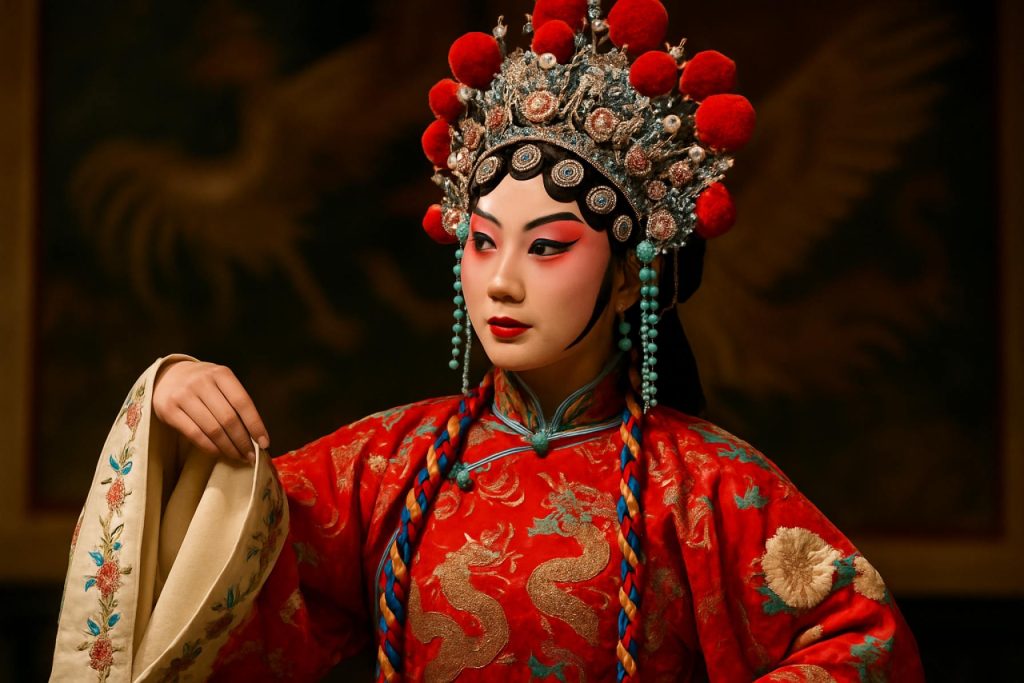
Discover the Enchanting World of Puxian Opera: A Journey Through Its Rich History, Unique Artistry, and Enduring Cultural Legacy
- Origins and Historical Evolution of Puxian Opera
- Key Characteristics and Artistic Styles
- Signature Roles and Iconic Performers
- Musical Instruments and Vocal Techniques
- Costume Design and Stagecraft Innovations
- Influence of Local Dialects and Folklore
- Notable Repertoires and Classic Performances
- Challenges in Preservation and Modernization
- Puxian Opera in Contemporary Chinese Culture
- Global Recognition and Future Prospects
- Sources & References
Origins and Historical Evolution of Puxian Opera
Puxian Opera, also known as Putian Opera, is a traditional Chinese opera form that originated in the Putian region of Fujian Province. Its roots can be traced back to the Song Dynasty (960–1279), making it one of the oldest regional operatic styles in China. The opera’s name derives from the historical term “Puxian,” which refers to the area encompassing present-day Putian and Xianyou counties. Over centuries, Puxian Opera has evolved by absorbing local folk music, dance, and narrative traditions, reflecting the unique linguistic and cultural characteristics of the region.
The early development of Puxian Opera was closely linked to religious rituals and community celebrations. Performances were often staged during temple fairs and festivals to honor deities and ancestors, serving both entertainment and spiritual functions. The opera’s repertoire initially consisted of stories from local legends, historical events, and classical literature, performed in the Puxian dialect—a branch of the Min Chinese language family. This linguistic distinctiveness has helped preserve the opera’s regional identity and fostered a strong sense of cultural continuity among local communities.
During the Ming (1368–1644) and Qing (1644–1912) dynasties, Puxian Opera underwent significant artistic development. The introduction of new musical instruments, costumes, and stage techniques enriched its expressive range. Troupes began to formalize performance conventions, including stylized singing, elaborate gestures, and symbolic movements. The opera also started to incorporate elements from other regional forms, such as Liyuan Opera and Gaojia Opera, leading to a more diverse and sophisticated artistic vocabulary. This period marked the transition of Puxian Opera from a primarily ritualistic practice to a recognized theatrical art form.
In the 20th century, Puxian Opera faced challenges due to social upheavals and changing cultural tastes. However, efforts by local artists, cultural organizations, and government bodies have played a crucial role in its preservation and revitalization. In 2006, Puxian Opera was inscribed on the first national list of Intangible Cultural Heritage by the State Council of the People’s Republic of China, recognizing its historical significance and cultural value (State Council of the People’s Republic of China). Today, Puxian Opera continues to be performed in Fujian and among overseas Chinese communities, serving as a living testament to the region’s rich artistic heritage.
Key Characteristics and Artistic Styles
Puxian Opera, also known as Putian Opera, is a traditional Chinese opera form originating from the Putian region in Fujian Province. It is recognized for its distinctive linguistic, musical, and performance features that set it apart from other regional operatic styles in China. The opera is performed in the Puxian dialect, a branch of the Min Chinese language family, which contributes to its unique vocal timbre and phrasing. This linguistic specificity not only preserves local culture but also presents a challenge for wider accessibility, as the dialect is not widely spoken outside the region.
Musically, Puxian Opera is characterized by its use of traditional Chinese instruments such as the erhu, pipa, and suona, which provide a rich and expressive accompaniment to the vocal performances. The melodies often employ pentatonic scales and are marked by a fluid, lyrical quality that complements the emotional depth of the stories being told. The vocal style is notable for its clarity and expressiveness, with performers employing a range of techniques to convey nuanced emotions and dramatic tension.
The artistic style of Puxian Opera is also evident in its staging and costuming. Performers wear elaborate costumes and makeup that reflect the roles they portray, such as scholars, officials, or mythological figures. The movements are highly stylized, with precise gestures and postures that are codified within the tradition. These movements are not only aesthetic but also serve as a visual language, conveying meaning and advancing the narrative in ways that transcend spoken dialogue.
A key characteristic of Puxian Opera is its integration of singing, speaking, acting, and acrobatics, a hallmark of Chinese opera forms. The choreography often includes martial arts sequences and symbolic dance, which add dynamism and visual interest to the performances. The stories presented in Puxian Opera are typically drawn from local folklore, historical events, and classical literature, emphasizing themes of loyalty, filial piety, and moral integrity.
Puxian Opera has been recognized as an important part of China’s intangible cultural heritage, with efforts underway to preserve and promote the art form. Organizations such as the Ministry of Culture and Tourism of the People's Republic of China have supported initiatives to document, teach, and stage Puxian Opera, ensuring its continued vitality for future generations.
Signature Roles and Iconic Performers
Puxian Opera, a traditional form of Chinese opera originating from the Putian region in Fujian Province, is renowned for its distinctive vocal style, elaborate costumes, and expressive performance techniques. Central to its enduring appeal are the signature roles and the iconic performers who have shaped its artistic legacy. The opera’s role system, like many Chinese operatic traditions, is structured around archetypal characters, each with unique attributes and performance conventions.
The primary role types in Puxian Opera include the Sheng (male roles), Dan (female roles), Jing (painted-face roles), and Chou (comic roles). Within these categories, further specialization exists. For example, the Laosheng (old male) and Xiaosheng (young male) are differentiated by age and temperament, while the Qingyi (virtuous young woman) and Huadan (vivacious young woman) represent contrasting female archetypes. The Jing roles, characterized by their elaborate facial makeup, often portray powerful or villainous figures, demanding both vocal prowess and physical expressiveness from the performer.
Throughout its history, Puxian Opera has produced a number of iconic performers whose artistry has become synonymous with the genre. Among the most celebrated is Lin Zhaohua, revered for his masterful interpretation of Laosheng roles, whose resonant voice and dignified stage presence set a benchmark for subsequent generations. Another legendary figure is Chen Meizhen, a Qingyi specialist, whose delicate yet emotionally charged performances have been widely acclaimed for their technical precision and depth of feeling. These artists not only preserved traditional repertoires but also contributed to the evolution of performance techniques, ensuring the opera’s continued relevance.
In recent decades, efforts to revitalize Puxian Opera have led to the emergence of new talents who blend classical training with innovative approaches. Troupes such as the Putian Puxian Opera Troupe have played a pivotal role in nurturing young performers and promoting the art form both domestically and internationally. These organizations are instrumental in organizing performances, educational programs, and cultural exchanges, thereby sustaining the opera’s vibrant tradition (China Culture).
The enduring appeal of Puxian Opera lies in the interplay between its signature roles and the virtuosity of its performers. Through the dedication of both past and present artists, the opera continues to captivate audiences, preserving a unique facet of China’s intangible cultural heritage.
Musical Instruments and Vocal Techniques
Puxian Opera, a traditional form of Chinese opera originating from the Putian region in Fujian Province, is distinguished by its unique blend of musical instruments and vocal techniques. The musical ensemble in Puxian Opera typically features a combination of string, wind, and percussion instruments, each contributing to the opera’s distinctive soundscape. Among the most prominent instruments are the erhu (a two-stringed bowed instrument), pipa (a four-stringed lute), and suona (a double-reed horn), which are commonly found in many forms of Chinese opera. However, Puxian Opera also incorporates local instruments such as the nanhu (a southern variant of the erhu) and various types of gongs and drums that provide rhythmic structure and dramatic emphasis.
The percussion section, often referred to as the “wuchang,” plays a crucial role in setting the tempo and accentuating the dramatic moments on stage. Instruments like the ban (wooden clapper), luo (gong), and dagu (large drum) are used to signal scene changes, highlight character entrances, and underscore emotional climaxes. The interplay between melodic and percussive elements is essential in creating the dynamic atmosphere characteristic of Puxian Opera performances.
Vocal techniques in Puxian Opera are equally distinctive. The singing style is marked by a clear, resonant timbre and a flexible use of vibrato, which allows performers to convey a wide range of emotions. The vocal delivery often alternates between recitative and melodic passages, with particular attention paid to the articulation of the regional Puxian dialect. This linguistic feature not only preserves local cultural identity but also adds a unique flavor to the opera’s sound. The principal vocal roles—sheng (male), dan (female), jing (painted face), and chou (comic)—each employ specialized vocal techniques and ornamentations suited to their character types.
Training in Puxian Opera emphasizes breath control, precise diction, and the ability to project the voice over the instrumental ensemble without amplification. Performers undergo rigorous instruction to master the subtle nuances of phrasing and tone color, ensuring that the vocal performance remains expressive and intelligible even in large venues. The integration of instrumental and vocal artistry in Puxian Opera reflects the genre’s deep roots in local tradition and its ongoing evolution as a living art form, recognized and supported by cultural authorities such as the Ministry of Culture and Tourism of the People's Republic of China.
Costume Design and Stagecraft Innovations
Puxian Opera, a traditional Chinese opera form originating from the Putian region in Fujian Province, is renowned for its distinctive costume design and innovative stagecraft. The costumes in Puxian Opera are characterized by their vibrant colors, intricate embroidery, and symbolic motifs, which not only reflect the regional aesthetic but also serve to delineate character types, social status, and narrative roles. Traditional garments such as the “mang” (embroidered robe) and “kao” (armor costume) are meticulously crafted, often utilizing silk and metallic threads to create elaborate patterns that signify the wearer’s identity, whether a noble, warrior, or deity. Headgear, including ornate crowns and hairpieces, further accentuates the visual splendor and helps convey the age, gender, and personality of each character.
Stagecraft in Puxian Opera has evolved to balance the preservation of classical techniques with the integration of modern theatrical innovations. Historically, performances were held on simple wooden stages, with minimal scenery and props, relying heavily on symbolic gestures and stylized movement to suggest setting and action. However, contemporary productions have embraced advancements in lighting, sound, and set design to enhance the audience’s immersive experience. For instance, dynamic lighting is now used to underscore dramatic moments or shift the mood, while modular stage elements allow for rapid scene changes without disrupting the flow of the performance.
One of the most notable innovations in Puxian Opera stagecraft is the creative use of space and audience interaction. Directors and stage designers have experimented with non-traditional stage layouts, such as theater-in-the-round or immersive environments, to break down the barrier between performers and spectators. This approach not only revitalizes traditional narratives but also attracts younger audiences and fosters a deeper appreciation for the art form.
The preservation and development of Puxian Opera’s costume and stagecraft traditions are supported by cultural institutions and government initiatives. Organizations such as the Ministry of Culture and Tourism of the People's Republic of China have recognized Puxian Opera as an important element of China’s intangible cultural heritage, providing funding and resources for research, training, and performance. Local troupes and academies in Fujian continue to innovate within the framework of tradition, ensuring that Puxian Opera remains a vibrant and evolving art form for future generations.
Influence of Local Dialects and Folklore
Puxian Opera, a traditional Chinese opera form originating from the Putian region in Fujian Province, is deeply intertwined with the local dialects and folklore of its native area. The opera is performed primarily in the Puxian dialect, a branch of the Min Chinese language family, which is distinct from Mandarin and other regional dialects. This linguistic foundation not only shapes the vocal delivery and lyrical structure of Puxian Opera but also preserves the unique phonetic and tonal qualities of the Puxian dialect, making the art form a living repository of local linguistic heritage. The use of the native dialect in performances ensures that the opera resonates with local audiences, fostering a strong sense of cultural identity and continuity.
Folklore plays a central role in the thematic content and narrative structure of Puxian Opera. Many of its stories are derived from local legends, historical events, and traditional tales passed down through generations. These narratives often reflect the values, beliefs, and social customs of the Putian region, providing insight into the collective memory and cultural psyche of its people. The incorporation of folklore not only enriches the dramatic content of the opera but also serves as a means of preserving and transmitting intangible cultural heritage. Through its performances, Puxian Opera brings to life the myths and legends that have shaped the identity of the region, ensuring their continued relevance in contemporary society.
The influence of local dialects and folklore is also evident in the musical and performative aspects of Puxian Opera. The melodies, rhythms, and vocal techniques are closely aligned with the tonal patterns of the Puxian dialect, while the choreography and stage movements often draw inspiration from traditional folk dances and rituals. Costumes and stage props frequently incorporate motifs and symbols from local folklore, further reinforcing the connection between the opera and its cultural roots. This integration of linguistic, narrative, and performative elements creates a distinctive artistic style that sets Puxian Opera apart from other regional opera forms in China.
Efforts to document and promote Puxian Opera, including its dialectal and folkloric influences, have been supported by cultural authorities such as the Ministry of Culture and Tourism of the People's Republic of China. These initiatives aim to safeguard the opera as an important element of China’s intangible cultural heritage, ensuring that the linguistic and folkloric traditions embedded within Puxian Opera continue to thrive for future generations.
Notable Repertoires and Classic Performances
Puxian Opera, also known as Putian Opera, is a traditional Chinese opera form originating from the Putian region in Fujian Province. Its repertoire is rich and diverse, reflecting centuries of local history, folklore, and cultural values. The notable repertoires of Puxian Opera are characterized by their unique blend of regional dialect, musical style, and performance techniques, which distinguish them from other forms of Chinese opera.
Among the most celebrated works in the Puxian Opera canon are historical dramas and folk tales that have been passed down through generations. Classic performances often include adaptations of well-known Chinese legends such as “The Butterfly Lovers” and “The Legend of the White Snake,” but with distinctive local interpretations and musical arrangements. Another frequently performed piece is “Chen San and Wu Niang,” a romantic tragedy that has become emblematic of the genre’s emotional depth and lyrical beauty.
Puxian Opera is also renowned for its martial plays, which showcase elaborate choreography and acrobatics. “The Battle of Red Cliffs” and “The Capture of the Tiger Mountain” are examples of such works, featuring dynamic stage combat and stylized movement. These performances not only entertain but also serve as a means of preserving traditional martial arts and stagecraft unique to the region.
A hallmark of Puxian Opera is its use of the Puxian dialect, which imbues the performances with local color and authenticity. The musical accompaniment typically features traditional Chinese instruments such as the erhu, pipa, and suona, creating a distinctive soundscape that supports both the vocal and dramatic elements of the opera. The costumes and makeup are equally notable, often reflecting the historical period or social status of the characters portrayed.
In recent years, efforts have been made to document and revitalize classic repertoires of Puxian Opera. The Ministry of Culture and Tourism of the People's Republic of China has recognized Puxian Opera as an important intangible cultural heritage, supporting initiatives to preserve and promote its traditional works. Local cultural organizations and opera troupes in Fujian continue to stage classic performances, ensuring that these treasured stories and artistic practices remain vibrant and accessible to new generations.
Challenges in Preservation and Modernization
Puxian Opera, a traditional form of Chinese opera originating from the Putian region in Fujian Province, faces significant challenges in both preservation and modernization. As a unique cultural heritage, it is characterized by its distinct dialect, stylized movements, and a repertoire deeply rooted in local folklore and history. However, the survival of Puxian Opera is threatened by a combination of social, economic, and cultural factors.
One of the primary challenges is the dwindling number of practitioners and audiences. With rapid urbanization and the migration of younger generations to larger cities, the traditional communities that once supported Puxian Opera have diminished. This demographic shift has led to a decline in both performers and knowledgeable audiences, making it difficult to sustain regular performances and pass on the art form to new generations. The language barrier posed by the Puxian dialect further limits its accessibility, even within Fujian Province.
Another significant challenge is the competition from modern entertainment forms. The proliferation of digital media, television, and popular music has shifted public interest away from traditional performing arts. Younger audiences, in particular, are less inclined to engage with Puxian Opera, perceiving it as outdated or irrelevant to contemporary life. This trend is exacerbated by the limited presence of Puxian Opera in mainstream media and educational curricula.
Efforts to modernize Puxian Opera have met with mixed results. While some troupes have experimented with integrating contemporary themes, staging techniques, and cross-genre collaborations, these innovations risk diluting the traditional essence of the art form. Striking a balance between authenticity and innovation remains a persistent dilemma for practitioners and cultural authorities. The challenge is to make Puxian Opera appealing to modern audiences without compromising its core artistic and cultural values.
Governmental and institutional support plays a crucial role in preservation efforts. The Chinese government, through agencies such as the Ministry of Culture and Tourism of the People's Republic of China, has designated Puxian Opera as an intangible cultural heritage, providing funding and policy support for its documentation, research, and promotion. Local cultural bureaus and dedicated opera troupes also contribute to training new performers and organizing community events. However, sustained investment and innovative outreach strategies are needed to ensure the long-term vitality of Puxian Opera in a rapidly changing cultural landscape.
Puxian Opera in Contemporary Chinese Culture
Puxian Opera, also known as Putian Opera, is a traditional form of Chinese opera originating from the Putian region in Fujian Province. With a history spanning over 800 years, it is recognized as one of the oldest regional operatic forms in China. In contemporary Chinese culture, Puxian Opera holds a unique position as both a living heritage and a symbol of regional identity. Its performances are characterized by distinctive vocal styles, elaborate costumes, and a repertoire that draws heavily from local folklore, historical tales, and classical literature.
In recent decades, the role of Puxian Opera has evolved in response to rapid social and cultural changes. Urbanization, modernization, and the proliferation of mass media have posed significant challenges to the survival of traditional performing arts. Despite these pressures, Puxian Opera has demonstrated resilience through adaptation and innovation. Local troupes, often supported by cultural bureaus and heritage organizations, have introduced new themes and modern staging techniques to attract younger audiences while preserving the core artistic elements of the genre.
The Chinese government has played a crucial role in safeguarding Puxian Opera as part of its broader commitment to intangible cultural heritage. In 2006, Puxian Opera was officially listed as a National Intangible Cultural Heritage, a designation that has facilitated increased funding, research, and promotional activities. This recognition underscores the opera’s cultural significance and has spurred initiatives such as educational outreach, archival documentation, and the training of new performers. The Ministry of Culture and Tourism, the principal governmental body overseeing cultural preservation, continues to support these efforts through policy guidance and resource allocation (Ministry of Culture and Tourism of the People's Republic of China).
In contemporary society, Puxian Opera is not only performed in traditional theaters but also featured at cultural festivals, schools, and community events. These performances serve as a bridge between generations, fostering a sense of continuity and belonging among local communities. Additionally, digital platforms and social media have enabled wider dissemination of Puxian Opera, allowing enthusiasts and scholars to access recordings, scripts, and academic studies from anywhere in the world. This digital presence has contributed to renewed interest and participation, both within China and among the global Chinese diaspora.
Overall, Puxian Opera’s enduring presence in contemporary Chinese culture reflects a dynamic interplay between tradition and modernity. Its ongoing revitalization efforts highlight the importance of cultural heritage in shaping collective identity and enriching the nation’s artistic landscape.
Global Recognition and Future Prospects
Puxian Opera, also known as Putian Opera, is a traditional Chinese opera form originating from the Putian region in Fujian Province. Despite its deep historical roots and unique artistic characteristics, Puxian Opera remains relatively lesser-known on the global stage compared to other Chinese opera genres such as Peking Opera or Cantonese Opera. However, recent efforts by cultural authorities and local organizations have aimed to elevate its profile internationally and ensure its preservation for future generations.
The global recognition of Puxian Opera has been gradually increasing, particularly following its inclusion in the national intangible cultural heritage list by the Chinese government. This designation, overseen by the Ministry of Culture and Tourism of the People's Republic of China, has provided a platform for greater visibility and support. The Ministry is responsible for the protection, promotion, and dissemination of China’s diverse cultural heritage, including traditional performing arts like Puxian Opera. Through government-backed initiatives, Puxian Opera troupes have participated in international cultural exchanges, festivals, and academic forums, introducing the art form to audiences beyond China’s borders.
In addition to official efforts, local organizations in Fujian, such as the Putian Puxian Opera Troupe, have played a crucial role in promoting the opera abroad. These groups often collaborate with cultural institutions and Confucius Institutes worldwide to stage performances and workshops, fostering cross-cultural understanding and appreciation. Such activities not only showcase the unique vocal techniques, costumes, and storytelling methods of Puxian Opera but also highlight its significance as a living cultural tradition.
Looking to the future, the prospects for Puxian Opera’s global recognition are promising but not without challenges. The ongoing digitization of cultural content, supported by the Ministry of Culture and Tourism of the People's Republic of China, offers new opportunities for international outreach through online performances, virtual exhibitions, and educational resources. These digital platforms can help bridge geographical gaps and attract younger, tech-savvy audiences worldwide. However, sustaining interest and ensuring the transmission of traditional skills require continued investment in training, research, and international collaboration.
In summary, while Puxian Opera is still on its journey toward widespread global recognition, concerted efforts by governmental and local bodies, combined with the possibilities offered by digital technology, are paving the way for its enduring presence and appreciation on the world stage.
Sources & References
- State Council of the People’s Republic of China
- Ministry of Culture and Tourism of the People's Republic of China



